TPN and the Role of Parenteral Lipids in Nutritional Support
Understanding the Critical Role of Lipids in Total Parenteral Nutrition
Total parenteral nutrition (TPN) is a vital clinical intervention utilized when the gastrointestinal tract cannot be used for nourishment. Central to the formulation of TPN are macronutrients, micronutrients, and fluids meticulously tailored to the patient’s needs. Among these, lipids serve as a key component, providing not only energy but also essential fatty acids that sustain cellular and physiological functions. This narrative explores the multifaceted role of parenteral lipids within TPN, their evolution, composition, influence on immune responses, clinical applications, and management strategies.
What is Total Parenteral Nutrition (TPN) and Its Main Components
What is total parenteral nutrition (TPN) and what are its main components?
Total parenteral nutrition (TPN) is a medical method used to provide complete nutrition directly into a patient's bloodstream via a central venous access point, bypassing the digestive system entirely. This approach is crucial when the gastrointestinal tract cannot be used due to conditions like severe intestinal failure, obstruction, or significant malabsorption.
The main components of TPN include macronutrients and micronutrients. The primary macronutrients are carbohydrates, proteins, and lipids, which supply the necessary calories and energy for bodily functions.
Macronutrients:
- Carbohydrates: Usually provided as dextrose solutions, they serve as the main energy source. The typical infusion provides around 3.4 kcal per gram of dextrose.
- Proteins: Delivered as amino acids derived from various formulations like TrophAmine or similar solutions, they supply essential and non-essential amino acids for tissue repair and maintenance.
- Lipids: Usually administered as emulsions (e.g., soybean oil-based, olive oil, fish oil, or mixed formulations), lipids provide a dense energy source (about 9 kcal per gram) and supply essential fatty acids.
In addition to macronutrients, micronutrients are included to meet the full spectrum of nutritional needs. These comprise:
- Vitamins: To support enzymatic reactions and metabolic processes.
- Minerals and Electrolytes: Such as sodium, potassium, chloride, calcium, magnesium, and phosphate to maintain fluid balance, nerve function, and muscle activity.
- Trace Elements: Including zinc, copper, manganese, and selenium, vital for various enzymatic functions.
The composition of TPN solutions must be carefully customized to each patient's specific requirements, considering factors like age, weight, clinical condition, and laboratory results. The solutions can be administered as a combined admixture or as separate infusions—such as lipid-only infusions or amino acid solutions—to ensure compatibility and stability.
Proper preparation and meticulous monitoring are essential to avoid complications like electrolyte imbalances, infections, or metabolic disturbances. The administration is typically carried out through central venous catheters, as the osmolarity of TPN solutions exceeds that suitable for peripheral veins.
In conclusion, TPN provides a tailored, comprehensive approach to nutrition support for patients who are unable to meet their nutritional needs through the enteral route, playing a vital role in the management of severe gastrointestinal impairment.
The Vital Functions and Significance of Lipids in Nutritional Support
What role do lipids play in nutritional support during TPN?
Lipids are a fundamental component of total parenteral nutrition (TPN), primarily serving as a dense energy source. Each gram of lipid provides approximately 9 kcal, making them essential for meeting the body's high caloric demands, especially in patients unable to utilize the gastrointestinal tract effectively. Beyond calories, lipids supply vital essential fatty acids like linoleic acid (an omega-6) and alpha-linolenic acid (an omega-3), which are crucial for maintaining cell membrane integrity and proper cellular function.
Lipids also help prevent essential fatty acid deficiency, which can develop within about three weeks of fat-free nutrition. They have a significant role in modulating immune responses and inflammatory processes, acting as precursors for inflammatory mediators such as eicosanoids. The type and composition of lipids — whether soybean oil-based, fish oil-enriched, or olive oil-containing emulsions — influence their biological effects. Newer formulations aim to reduce inflammation and promote liver health, especially in critically ill or postoperative patients.
Overall, lipids contribute more than just energy in TPN. They are central to supporting cellular structure, immune defenses, and metabolic stability. Proper selection and monitoring of lipid emulsions are vital to optimize clinical outcomes and minimize adverse effects.
Diverse Types and Compositions of Lipid Emulsions in TPN
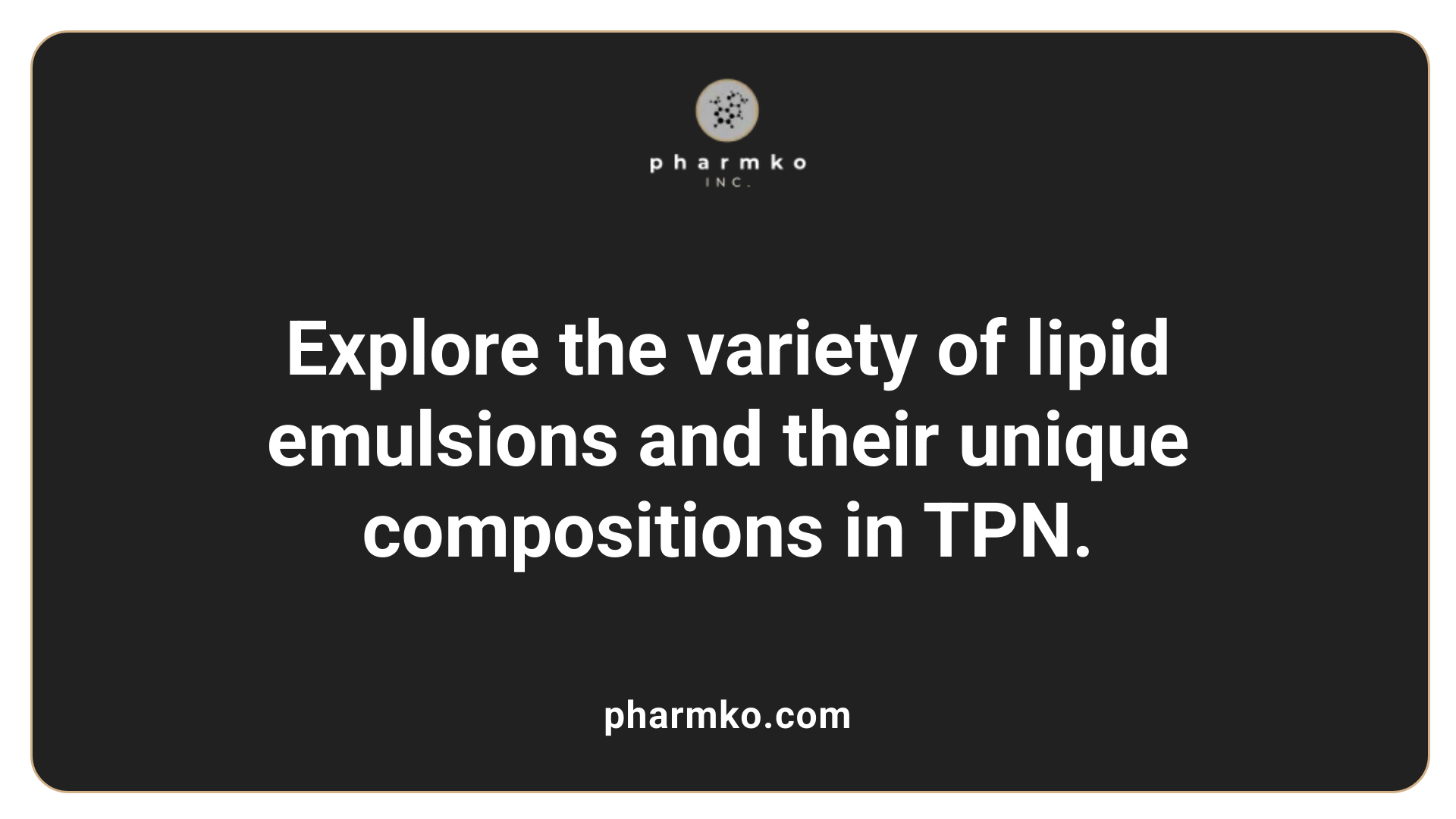
What are the different types and compositions of lipid emulsions used in TPN?
Lipid emulsions in total parenteral nutrition (TPN) are mainly formulated from triglycerides sourced from various oils, each influencing their fatty acid content and clinical effects. The most traditional and widely used emulsion is soybean oil-based, which is high in omega-6 polyunsaturated fatty acids (PUFAs). These omega-6 rich emulsions are pro-inflammatory and have been associated with adverse liver effects when used in high doses or long-term.
As alternatives, olive oil-based emulsions contain predominantly monounsaturated fats, mainly oleic acid, which have a more neutral or slightly anti-inflammatory profile. Fish oil-based emulsions are particularly notable because they contain omega-3 fatty acids such as eicosapentaenoic acid (EPA) and docosahexaenoic acid (DHA), which are known for their anti-inflammatory and immunomodulatory properties.
In recent years, advances have led to the development of mixed formulations. For instance, SMOFlipid combines soybean oil, olive oil, medium-chain triglycerides (MCTs), and fish oil. These structured triglyceride emulsions aim to deliver a balanced profile of fatty acids, reducing inflammatory potential while providing essential fatty acids and supporting metabolic efficiency.
In addition to triglycerides, these emulsions contain important bioactive components, including phospholipids, which act as emulsifiers; phytosterols, which influence cholesterol metabolism; and vitamin E (α-tocopherol), an antioxidant that protects against lipid peroxidation. The overall composition and choice of lipid emulsion depend on the clinical context, such as reducing inflammation, supporting immune function, and minimizing risks of liver toxicity.
The selection process considers the patient's specific needs, aiming to optimize clinical outcomes by tailoring the fatty acid profile of the lipid formulation used in TPN.
| Lipid Source | Fatty Acid Profile | Clinical Role | Additional Components |
|---|---|---|---|
| Soybean oil-based | Rich in omega-6 PUFAs (linoleic acid) | Pro-inflammatory potential; common in traditional TPN formulations | Phospholipids, phytosterols, vitamin E |
| Olive oil-based | Monounsaturated fats (oleic acid) | Supports immune health; anti-inflammatory effect | Phytosterols, antioxidants |
| Fish oil-based | Omega-3 PUFAs (EPA, DHA) | Anti-inflammatory; immune modulation | Antioxidants, specific bioactive lipids |
| Mixed emulsions (e.g., SMOFlipid) | Balanced profile of saturated, monounsaturated, and omega-3 | Reduced inflammation and liver toxicity risk | Phospholipids, emulsifiers |
How do various lipid formulations impact clinical outcomes?
Clinical studies suggest that formulations rich in omega-3 PUFAs, such as fish oil-based emulsions, may lower infection rates, decrease inflammation, and support recovery in critically ill and post-surgical patients. They also show promise in reducing liver complications associated with long-term TPN.
Conversely, soybean oil emulsions high in omega-6 fatty acids might promote inflammation and liver damage if used excessively. Hence, newer formulations seek to balance fatty acid profiles to support immune function, reduce adverse effects, and optimize nutritional therapy.
Tailoring lipid formulations according to patient needs is crucial. For example, patients with inflammatory conditions may benefit from fish oil emulsions, while those needing rapid energy might receive soybean oil-based emulsions, provided safety considerations are met.
In summary, the evolution of lipid emulsions in TPN reflects an understanding that composition matters. The choice of emulsion influences not only energy provision but also inflammation, immune response, and potential toxicity, underscoring the importance of personalized nutritional strategies.
Evolution of Lipid Formulations and Their Impact on Patient Outcomes
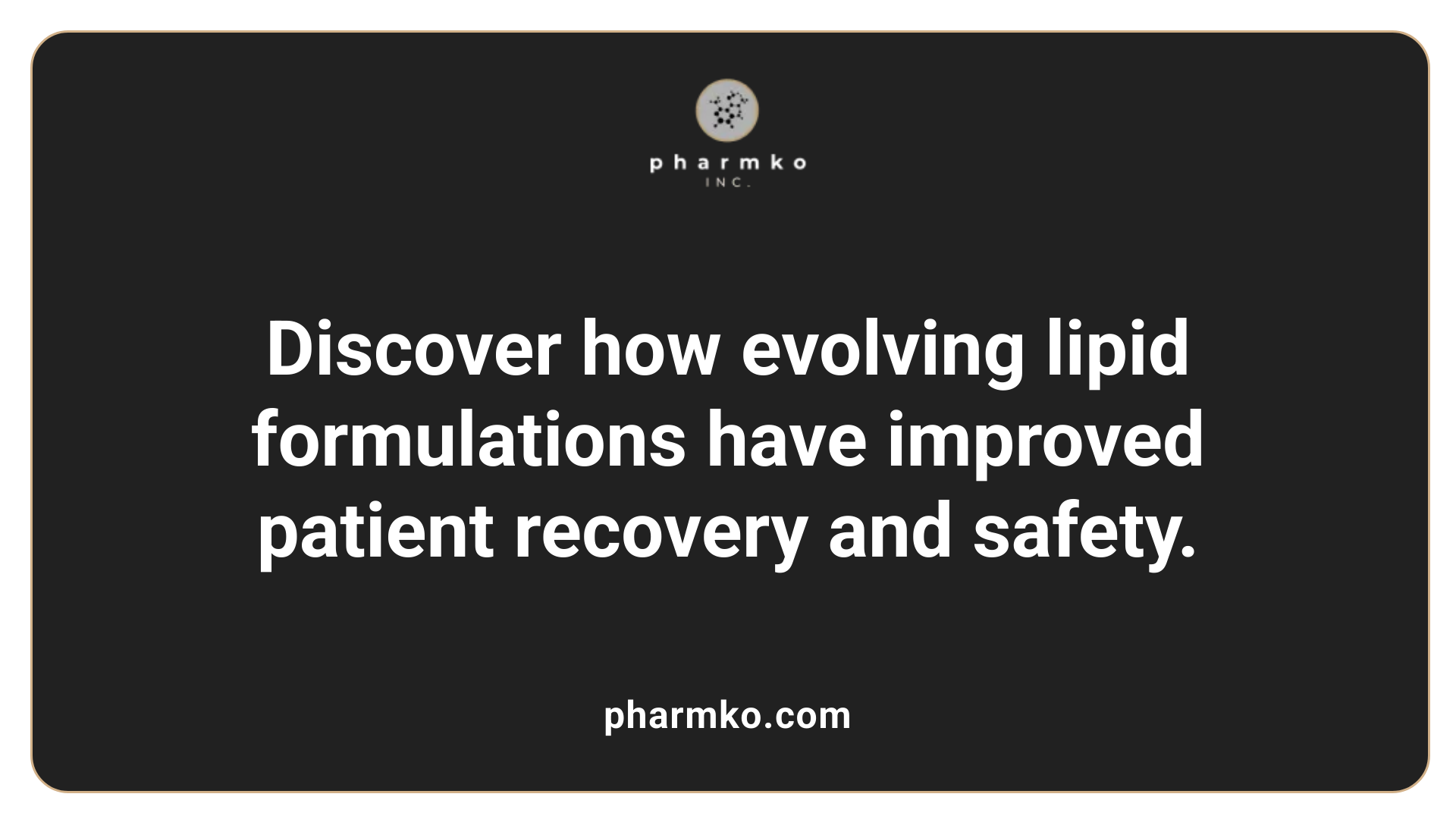
How have lipid formulations in TPN evolved over time to improve patient outcomes?
The development of lipid emulsions used in total parenteral nutrition (TPN) has undergone significant transformation over the past several decades. Initially, soybean oil-based emulsions, rich in omega-6 polyunsaturated fatty acids (PUFAs), were the mainstay, providing essential fatty acids (EFAs) and energy-dense calories. While effective, these formulations were associated with potential pro-inflammatory effects and risks of liver dysfunction when used long-term.
Recognizing these limitations, clinicians and researchers have pursued new formulations aimed at reducing inflammation and improving safety. Alternative lipid sources such as medium-chain triglycerides (MCTs), olive oil, and fish oil have been incorporated into newer emulsions. For example, fish oil-based emulsions, rich in omega-3 fatty acids, exhibit anti-inflammatory properties and contribute to protection against PN-associated liver disease.
Progress in emulsion technology has also introduced advanced delivery systems such as nanoemulsions and lipid nanocarriers. These innovations enhance stability, improve solubility of lipophilic drugs, and enable targeted delivery, all contributing to better tolerability and therapeutic outcomes.
Recent formulations, often combining multiple lipid sources—such as soybean, olive oil, safflower, and fish oils—aim to balance pro- and anti-inflammatory effects. These mixed lipids have been associated with reduced infection rates, shorter ICU stays, and diminished complications related to inflammation.
Furthermore, ongoing research into the interaction between these lipid formulations and nuclear receptors like PPARα suggests mechanisms by which omega-3 fatty acids modulate gene expression involved in inflammation and lipid metabolism.
Overall, the evolution from traditional soybean oil emulsions to more sophisticated, mixed-source, and fish oil-rich emulsions reflects a strategic effort to tailor lipid therapy to specific patient needs, thereby improving safety, reducing adverse effects, and enhancing clinical outcomes in patients receiving parenteral nutrition.
| Timeline | Lipid Formulation | Main Characteristics | Clinical Impact | Additional Notes |
|---|---|---|---|---|
| 1960s | Soybean oil emulsions | High omega-6 PUFAs, energy-dense | Pro-inflammatory potential | Mainstay until recent years |
| Recent decades | MCT and olive oil emulsions | MCTs for rapid metabolism; olive oil rich in oleic acid | Reduced inflammation, better liver tolerance | Used in neonatal and adult PN |
| Recent years | Fish oil-based emulsions | Rich in omega-3 PUFAs (EPA and DHA) | Anti-inflammatory, immune-modulating | Shown to reduce PN-related liver disease |
| Current trend | Mixed-lipid emulsions | Combines soybean, olive, safflower, fish oils | Balances effects; personalized therapy | Aims to optimize outcomes |
How have lipid formulations in TPN evolved over time to improve patient outcomes?
Lipid formulations in parenteral nutrition have significantly evolved over time to enhance patient outcomes by improving safety, tolerability, and therapeutic efficacy. Traditional lipid emulsions based on soybean oil have been supplemented or replaced with alternative sources such as MCT, olive oil, and fish oil to mitigate adverse effects like oxidative stress and inflammation. Advances include the development of mixed lipid emulsions, nanoemulsions, and lipid nanocarriers, which offer improved stability, targeted delivery, and better solubility for drugs. Incorporation of omega-3 fatty acids from fish oil has shown anti-inflammatory effects and potential protection against PN-associated liver disease, partly through interactions with nuclear receptors like PPARα. Overall, these developments aim to tailor lipid formulations to specific patient populations, reduce complications, and optimize clinical outcomes in parenteral nutrition.
Lipids and Their Impact on Immune Function and Inflammatory Responses
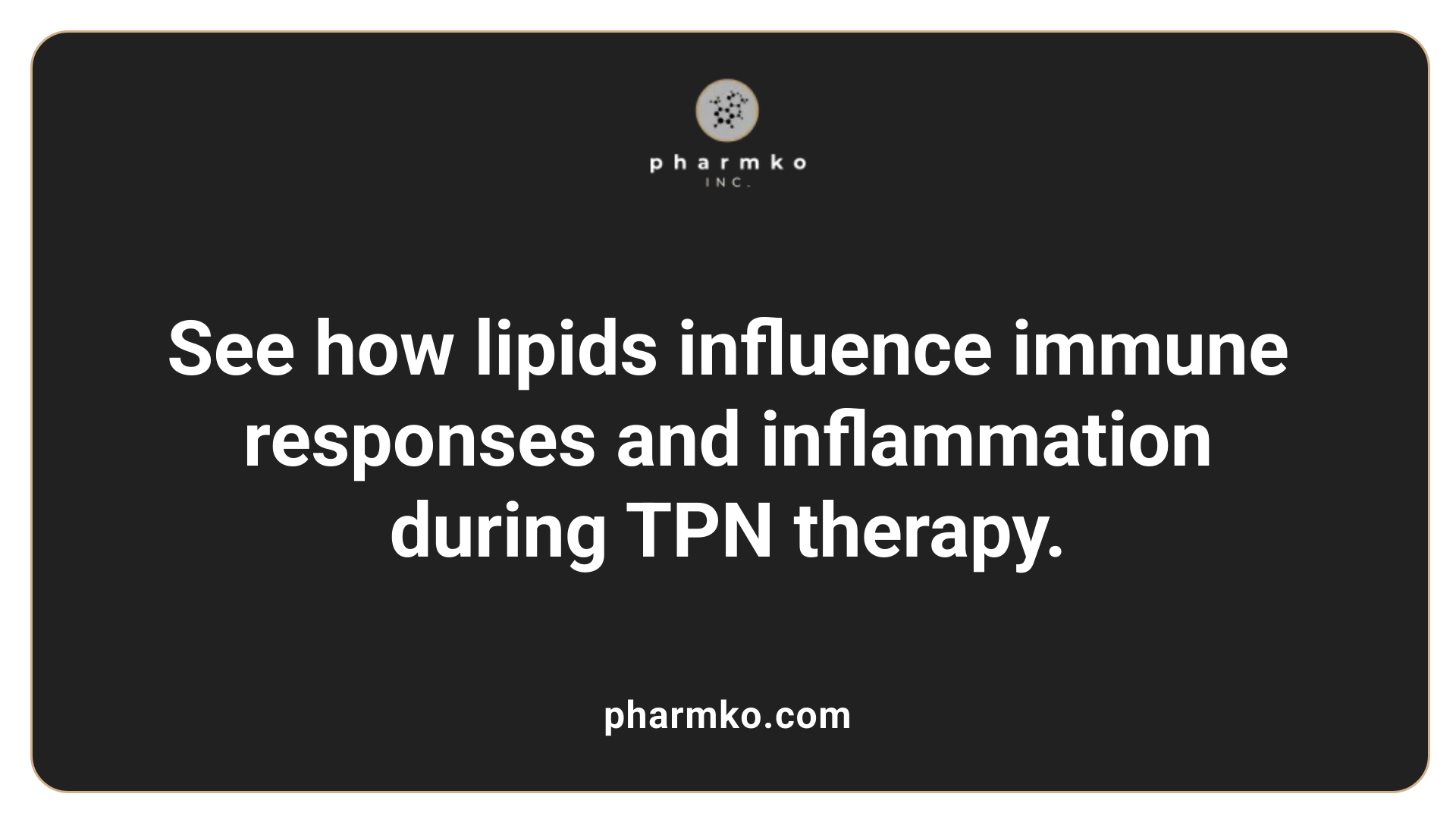
How do lipids influence immune function and inflammation in patients receiving TPN?
Lipids, as essential components of total parenteral nutrition (TPN), play a vital role not just in energy provision but also in modulating immune responses and inflammation. They are sources of essential fatty acids (EFAs), which serve as precursors for bioactive lipid mediators such as eicosanoids, impacting immune cell behavior, cytokine production, and inflammatory pathways.
The composition of lipid emulsions (LEs) used in TPN significantly affects these processes. Traditionally, soybean oil-based emulsions are rich in omega-6 polyunsaturated fatty acids (n−6 PUFAs), which tend to promote pro-inflammatory responses. These emulsions, while effective in supplying calories, can contribute to increased inflammation and immune suppression if used excessively or in sensitive populations.
In contrast, emulsions enriched with omega-3 fatty acids—particularly those derived from fish oil—exert anti-inflammatory effects. Omega-3 PUFAs, such as eicosapentaenoic acid (EPA) and docosahexaenoic acid (DHA), can shift the balance of lipid mediators from pro-inflammatory to pro-resolving eicosanoids and resolvins, thereby dampening excessive inflammation and modulating immune cell activity.
Clinical studies have demonstrated that supplementing TPN with fish oil or omega-3 fatty acids enhances immune regulation. For example, patients receiving fish oil-rich emulsions often show reduced levels of inflammatory cytokines, improved immune cell function, and better clinical outcomes post-surgery. These benefits are particularly significant in critically ill and post-operative patients, where uncontrolled inflammation can hinder recovery.
However, the influence of lipid emulsions on immune function is complex and context-dependent. While omega-3 rich emulsions tend to be beneficial in reducing harmful inflammation, over-supplementation can impair immune defenses if not carefully balanced. Moreover, high levels of omega-6 fatty acids from traditional soybean-based emulsions can enhance inflammatory responses and potentially predispose patients to infections or delayed recovery.
Research continues to explore the optimal composition of lipid emulsions to support immune health, with newer formulations combining various oil sources to harness both anti-inflammatory and immune-supportive properties. Overall, tailoring lipid composition in TPN formulations is critical for modulating immune responses, reducing inflammation-related complications, and improving patient outcomes.
Guidelines and Best Practices for Lipid Administration in TPN
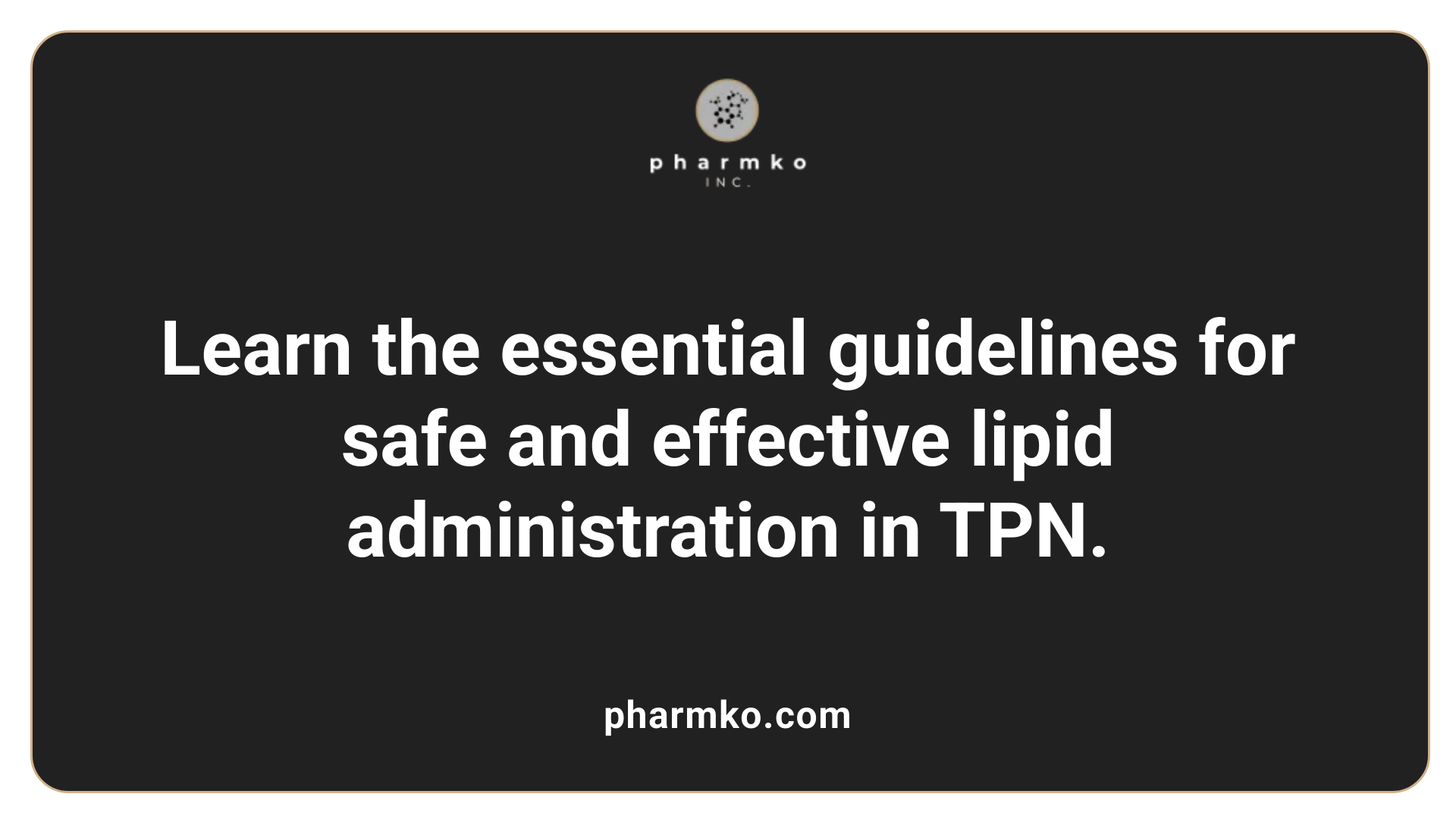
What are the guidelines for administering, managing, and monitoring lipids in TPN therapy?
Administering lipids safely and effectively within Total Parenteral Nutrition (TPN) requires careful attention to dosing, formulation, and patient-specific factors. Typically, lipids are provided as part of TPN to supply around 25-30% of total caloric intake, which translates to about 0.8-1 g/kg/day of lipid emulsions in stable adult patients. In critically ill or unstable patients, the lipid dose might be adjusted based on individual metabolic tolerance and clinical judgment.
Lipid emulsions are formulated to include various sources such as soybean oil, olive oil, fish oil, and Medium-Chain Triglycerides (MCTs). The choice should be tailored to the patient’s needs, considering factors such as inflammation, liver function, and risk of adverse effects.
Monitoring consists of regular laboratory assessments focusing on serum triglyceride levels, liver function tests (LFTs), electrolytes, blood glucose, and other nutritional markers. Triglyceride levels should be checked periodically, especially in patients at higher risk for hyperlipidemia or with impaired lipid clearance. If triglycerides exceed 400 mg/dL, lipid infusion should be reduced or paused.
It is crucial to observe for clinical signs of lipid intolerance, including Fat Overload Syndrome, which can present with symptoms like fever, hepatosplenomegaly, respiratory distress, and organ dysfunction. These require prompt management, potentially involving slowing or stopping lipid infusion.
Choosing appropriate lipid emulsions for patient needs
Recent advances include the development of mixed lipid emulsions that combine soybean oil, olive oil, MCTs, and fish oil. These formulations aim to provide essential fatty acids, reduce pro-inflammatory n−6 polyunsaturated fatty acids, and leverage the anti-inflammatory properties of omega-3 fatty acids from fish oil.
In patients with specific conditions such as liver dysfunction, immune modulation needs, or high inflammatory states, fish oil-based emulsions may offer benefits due to their anti-inflammatory effects.
The vitamin K content, especially in soybean oil emulsions, is also a vital consideration, particularly in patients on anticoagulants like warfarin, where vitamin K can influence anticoagulation status.
Management of contraindications and adverse effects
Contraindications include patients with known hypersensitivity to components of lipid emulsions, severe hyperlipidemia, or conditions where lipid clearance is markedly impaired, such as in certain liver or kidney diseases.
In cases of adverse effects, such as elevated triglycerides, hyperglycemia, or signs of Fat Overload Syndrome, clinicians should adjust the lipid dose accordingly and consider switching to alternative formulations. Monitoring for liver toxicity and cholestasis is also essential, particularly with long-term lipid infusion.
To prevent complications, lipid emulsions should be administered via central venous catheters to accommodate their osmolarity and reduce the risk of phlebitis. Precautions include avoiding additions of electrolytes unless reviewed and prepared by experienced pharmacists and ensuring compatibility of all TPN components.
Overall, the management of lipids in TPN is a dynamic process involving appropriate selection, vigilant monitoring, and adjustments tailored to the patient's clinical course and response, guided by evolving evidence and expert clinical consensus.
| Aspect | Recommendations | Additional Notes |
|---|---|---|
| Dosing | Up to 30% of total calories (~0.8-1 g/kg/day) in stable patients | Adjust in critically ill or impaired clearance patients |
| Monitoring | Serum triglycerides, liver function, blood glucose, electrolytes | Check triglycerides regularly; stop if >400 mg/dL |
| Lipid selection | Use mixed emulsions (soy, olive, fish, MCT) based on clinical needs | Fish oil for anti-inflammatory benefits |
| Contraindications | Severe hyperlipidemia, lipid clearance impairment, allergies | Review all components with pharmacist |
| Adverse effect management | Reduce or stop lipids; monitor for Fat Overload Syndrome | Address hyperglycemia and liver toxicity promptly |
Benefits, Risks, and Special Applications of Parenteral Lipids
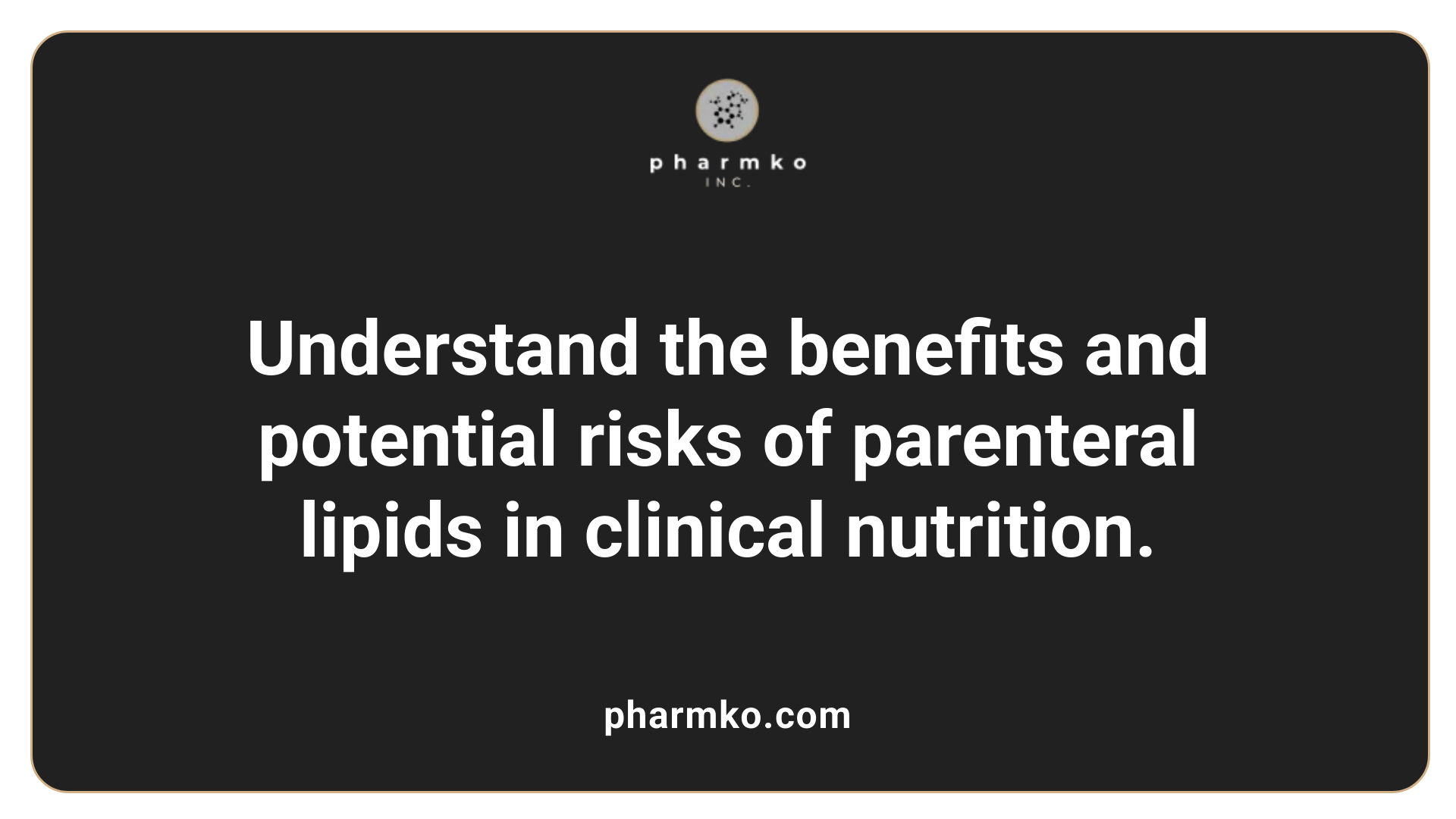
What are the benefits and potential risks associated with parenteral lipids?
Parenteral lipids serve multiple vital functions in clinical nutrition. They are a primary source of essential fatty acids (EFAs), which are crucial for maintaining cellular membrane integrity, immune responses, and hormone synthesis. Furthermore, lipids are energy-dense, providing approximately 9 kcal per gram, which helps meet the high caloric needs of critically ill patients and those with compromised gastrointestinal function.
In addition to their structural roles, lipid emulsions—especially those containing omega-3 fatty acids derived from fish oil—exhibit anti-inflammatory and immunomodulatory effects. These properties can lead to improved clinical outcomes, such as reduced infection rates, shorter hospital stays, and mitigation of parenteral nutrition-associated liver disease (PNALD). The newer formulations, like mixed or fish oil-rich emulsions, are designed to optimize benefits by balancing the anti-inflammatory effects with minimal pro-inflammatory potential.
However, these benefits come with potential risks. High doses or prolonged infusion of lipids, notably soybean oil-based emulsions rich in omega-6 polyunsaturated fatty acids (PUFAs), may promote inflammation, immunosuppression, and liver toxicity. Hypertriglyceridemia—elevated triglyceride levels in the blood—can occur, especially in patients with impaired lipid clearance such as those with liver dysfunction or sepsis. There is also concern about increased infection risks due to immune modulation effects. These adverse outcomes emphasize the importance of individualized lipid selection, dosing, and vigilant monitoring during parenteral nutrition therapy.
Supportive use of lipids in vulnerable populations like premature infants
Lipid therapy plays a particularly critical role in supporting vulnerable groups, including premature infants. These infants have limited fat stores and require essential fatty acids for essential physiological processes and optimal development. Early initiation of lipid emulsions, especially those rich in long-chain polyunsaturated fatty acids like DHA and EPA, are vital for supporting brain growth, neurodevelopment, and immune defense.
In neonatal intensive care, tailored lipid provision helps prevent deficiencies that could impact long-term neurological and physical outcomes. Lipids also contribute to reducing the risk of necrotizing enterocolitis and support growth trajectories. Proper dosing and careful monitoring are essential to avoid excess lipid administration, which could predispose to cardiovascular issues later in life.
The formulation choice—favoring emulsions with balanced omega-6 and omega-3 fatty acids—is crucial for optimizing benefits while minimizing adverse effects such as inflammation or lipid intolerance. Overall, lipid supplementation in premature and fragile infants should be a carefully managed component of neonatal care, aimed at enhancing survival, growth, and neurodevelopment.
Summary: The Future of Parenteral Lipids in Nutritional Therapy
The integration of diverse lipid emulsions into TPN has revolutionized nutritional support, emphasizing the importance of tailored lipid therapy. Advancements such as fish oil-enriched emulsions demonstrate promising anti-inflammatory and immune-modulating properties, potentially reducing complications like liver toxicity and infection rates. As scientific understanding deepens, personalized lipid formulations will likely become standard practice, optimizing outcomes across patient populations—from neonates to critically ill adults. Continued research and adherence to best practices will ensure the safe and effective employment of parenteral lipids, solidifying their role as a cornerstone in nutritional therapy.
References
- Parenteral Nutrition and Lipids - PMC - PubMed Central
- Total Parenteral Nutrition - StatPearls - NCBI Bookshelf
- TPN and Lipids: Nourishing the Body Beyond Energy
- Lipid clearance and total parenteral nutrition - ScienceDirect.com
- Immune modulation by parenteral lipid emulsions - ScienceDirect.com
- Parenteral Nutrition - BAPEN
- Composition and Functionality of Lipid Emulsions in Parenteral ...
- [PDF] The Hitchhiker's Guide to Parenteral Nutrition Management for Adult ...













